 W
WThe Battle of Berlin, designated as the Berlin Strategic Offensive Operation by the Soviet Union, and also known as the Fall of Berlin, was one of the last major offensives of the European theatre of World War II.
 W
WThe 11th SS Volunteer Panzergrenadier Division Nordland was a Waffen-SS division recruited from foreign volunteers and conscripts. It saw action, as part of Army Group North, in the Independent State of Croatia and on the Eastern Front during World War II.
 W
WErich Bärenfänger was a German general during World War II. He was a recipient of the Knight's Cross of the Iron Cross with Oak Leaves and Swords of Nazi Germany. In the final days of the war, Bärenfänger was commander of several defense sectors during the Battle of Berlin; he committed suicide on 2 May 1945.
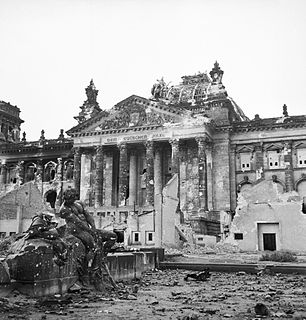 W
WThe battle in Berlin was an end phase of the Battle of Berlin. While the Battle of Berlin encompassed the attack by three Soviet Army Groups to capture not only Berlin but the territory of Germany east of the River Elbe still under German control, the battle in Berlin details the fighting and German capitulation that took place within the city.
 W
WThis is the order of battle that took place on April 16, 1945, in the end stages of World War II, between the German Wehrmacht and the Soviet Red Army. This battle took place before the start of the Battle of the Oder–Neisse and concluded with the Battle in Berlin. Units are listed as they were deployed from North to South before the start of the Battle of the Seelow Heights.
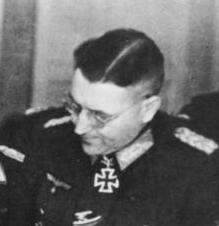 W
WErnst Hermann August Theodor Busse was a German officer during World War I and World War II.
 W
WAdolf Hitler, the Austrian-born German politician who was the leader of the Nazi Party, Chancellor of Germany from 1933 to 1945, and Führer ('Leader') of Nazi Germany from 1934 to 1945, committed suicide by gunshot on 30 April 1945 in his Führerbunker in Berlin. Eva Braun, his wife of one day, committed suicide with him by taking cyanide. In accordance with his prior written and verbal instructions, that afternoon their remains were carried up the stairs through the bunker's emergency exit, doused in petrol, and set alight in the Reich Chancellery garden outside the bunker.
 W
WFlak towers were large, above-ground, anti-aircraft gun blockhouse towers constructed by Nazi Germany. There were 8 flak tower complexes in the cities of Berlin (3), Hamburg (2), and Vienna (3) from 1940 onwards. Other cities that used flak towers included Stuttgart and Frankfurt. Smaller single-purpose flak towers were built at key outlying German strongpoints, such as at Angers in France, Helgoland in Germany.
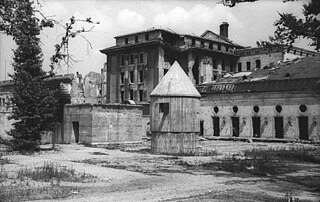 W
WThe Führerbunker was an air raid shelter located near the Reich Chancellery in Berlin, Germany. It was part of a subterranean bunker complex constructed in two phases in 1936 and 1944. It was the last of the Führer Headquarters (Führerhauptquartiere) used by Adolf Hitler during World War II.
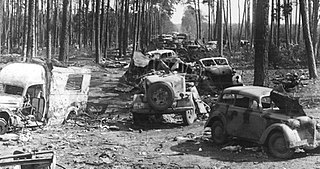 W
WThe Battle of Halbe from April 24 – May 1, 1945 was a battle in which the German Ninth Army, under the command of General Theodor Busse, was destroyed as a fighting force by the Red Army during the Battle of Berlin.
 W
WMeliton Varlamis dze Kantaria or Kantariya was a Georgian sergeant of the Soviet Army credited with having hoisted a Soviet flag over the Reichstag on 30 April 1945, together with Mikhail Yegorov and Aleksey Berest.
 W
WYevgeny Ananyevich Khaldei was a Soviet Red Army naval officer and photographer. He is best known for his World War II photograph of a Soviet soldier raising a flag over the Reichstag in Berlin, capital of the vanquished Nazi Germany, at the close of the war.
 W
WThe Leonidas Squadron, formally known as 5th Staffel of Kampfgeschwader 200, was a unit which was originally formed to fly the Fieseler Fi 103R (Reichenberg), a manned version of the V-1 flying bomb, in attacks in which the pilot was likely to be killed, or at best to parachute down at the attack site. The Reichenberg was never used in combat because Werner Baumbach, the commander of KG 200, and his superiors considered it an unnecessary waste of life and resources, and preferred to use the Mistel composite aircraft aerial ordnance system instead. The Mistel composite design was piloted from a regular Luftwaffe single-seat fighter used as the "upper component" forming the guidance system, mounted as an integral parasite aircraft, as the only manned part, mounted atop the unmanned, shaped charge-nosed "expendable lower component" of the Mistel aircraft system, as in its target dive, the single-seat pilot released the lower, unmanned flying bomb component aircraft towards its target, while the upper component, manned fighter "guidance component" returned to base.
 W
WThe Medal "For the Capture of Berlin" was a World War II campaign medal of the Soviet Union established on June 9, 1945 by decree of the Presidium of the Supreme Soviet of the USSR to satisfy the petition of the People's Commissariat for Defense of the Soviet Union. The medal's statute was amended on July 18, 1980 by decree of the Presidium of the Supreme Soviet of the USSR № 2523-X.
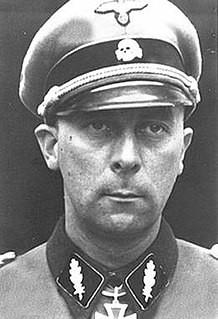 W
WWilhelm Mohnke was one of the original members of the SS-Staff Guard (Stabswache) "Berlin" formed in March 1933. From those ranks, Mohnke rose to become one of Adolf Hitler's last remaining generals. He joined the Nazi Party in September 1931.
 W
WThe Battle of the Oder–Neisse is the German name for the initial (operational) phase of one of the last two strategic offensives conducted by the Red Army in the Campaign in Central Europe during World War II. Its initial breakthrough phase was fought over four days, from 16 April until 19 April 1945, within the larger context of the Battle of Berlin. The Soviet military planners divide the frontal and pincer phases of the operation, named Berlin Strategic Offensive Operation into:Stettin–Rostock Offensive Operation by the 2nd Belorussian Front Seelow–Berlin Offensive Operation by the 1st Belorussian Front Cottbus–Potsdam Offensive Operation by the northern flank and Cavalry Mechanized Group of the 1st Ukrainian Front Spremberg–Torgau Offensive Operation by the southern flank of the 1st Ukrainian Front
 W
WThe Race to Berlin was a competition between Soviet Marshals Georgy Zhukov and Ivan Konev to be the first to enter Berlin during the final months of World War II in Europe.
 W
WRaising a Flag over the Reichstag is an iconic World War II photograph, taken during the Battle of Berlin on 2 May 1945. The photograph was reprinted in thousands of publications and came to be regarded around the world as one of the most significant and recognizable images of World War II. Owing to the secrecy of Soviet media, the identities of the men in the picture were often disputed, as was that of the photographer, Yevgeny Khaldei. It became a symbol of the Soviet victory over Nazi Germany.
 W
WHellmuth Reymann was an officer in the German Army (Heer) during World War II. He was one of the last commanders of the Berlin Defence Area during the final assault by Soviet forces on Berlin.
 W
WThe Battle of the Seelow Heights was part of the Berlin Strategic Offensive Operation. A pitched battle, it was one of the last assaults on large entrenched defensive positions of the Second World War. It was fought over three days, from 16–19 April 1945. Close to 1,000,000 Soviet soldiers of the 1st Belorussian Front, commanded by Marshal Georgi Zhukov, attacked the position known as the "Gates of Berlin". They were opposed by about 110,000 soldiers of the German 9th Army, commanded by General Theodor Busse, as part of the Army Group Vistula.
 W
WThe Vorbunker was an underground concrete structure originally intended to be a temporary air-raid shelter for Adolf Hitler and his guards and servants. It was located behind the large reception hall that was added onto the old Reich Chancellery, in Berlin, Germany, in 1936. The bunker was officially called the "Reich Chancellery Air-Raid Shelter" until 1943, when the complex was expanded with the addition of the Führerbunker, located one level below. On 16 January 1945, Hitler moved into the Führerbunker. He was joined by his senior staff, including Martin Bormann. Later, Eva Braun and Joseph Goebbels moved into the Führerbunker while Magda Goebbels and their six children took residence in the upper Vorbunker. The Goebbels family lived in the Vorbunker until their deaths on 1 May 1945.
 W
WHelmuth Otto Ludwig Weidling was a German general during World War II. He was the last commander of the Berlin Defence Area during the Battle of Berlin, and led the defence of the city against Soviet forces, finally surrendering just before the end of World War II in Europe.
 W
WMikhail Alekseyevich Yegorov, along with Meliton Kantaria, was one of the three soldiers credited with raising the Soviet flag over the Reichstag on the 2 May 1945 after the Battle of Berlin.
 W
WThe Zoo flak tower was a fortified flak tower that existed in Berlin from 1941 to 1947. It was one of several flak towers that protected Berlin from Allied bomber raids. Its primary role was as a gun platform to protect the government building district of Berlin; in addition, the Hochbunker (blockhouse) was designed to be used as a civilian air-raid shelter. It also contained a hospital and a radio transmitter for use by the German leadership, and provided secure storage facilities for art treasures.